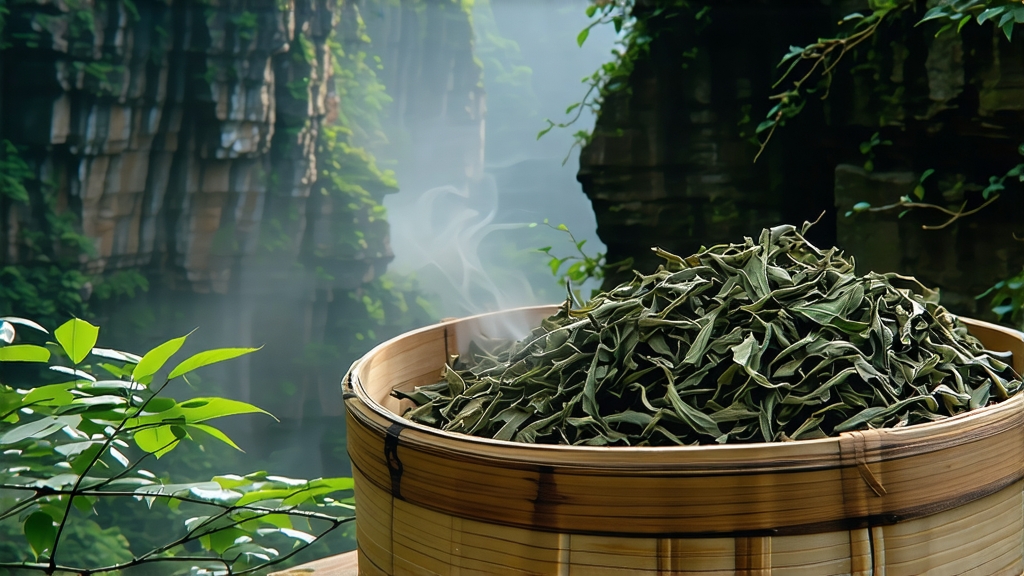
Long before English breakfast tables knew the word “black tea,” caravans carried small, leathery leaves out of the Wuyi Mountains of northern Fujian. Those leaves—fermented, fired, and scented with pinewood smoke—were the first red tea (hong cha) ever created, later christened by Western merchants Lapsang Souchong. Today the name evokes everything from campfire romance to whisky-barrel nuance, yet its authentic story is rooted in one narrow gorge, one accidental harvest, and one ingenious farmer who saved the crop.
Origin & Myth
Tongmu Village, a protected enclave inside the Wuyi UNESCO heritage site, sits at 27° north latitude where mist drifts year-round through granite cliffs and mineral-rich streams. Legend says that in 1646, Qing soldiers quartered themselves in tea sheds during the transition from Ming loyalists. To dry the leaf quickly before the troops returned, workers spread it over pine fires. The smoke penetrated the withering leaves, and the improbable flavor—resinous, fruity, mysteriously sweet—was an instant hit with the Dutch traders waiting at Xiamen port. By 1669 the British East India Company listed “Bohea Souchong” at twice the price of green tea, and a global craving for “black” tea was born.
True vs. Tarry
Walk into any European gourmet shop and you may meet a blunt, tarry “Lapsang” meant to scent cocktails. That aggressive profile comes from added smoke essences, not from the traditional craft. Authentic Tongmu Lapsang Souchong uses only local pine (Pinus massoniana) that has aged three years, allowing resin to mellow. Two versions survive:
- Traditional Smoke-dried: Leaves wither over gentle pinewood embers, then roll, oxidize 90-95 %, and are finally hot-smoked in wooden chambers called qinglou. The smoke is cool enough to avoid scorching, yet warm enough to drive moisture while layering phenols that bond with theaflavins, creating a natural sweetness beneath the campfire note.
- Unsmoked “New Craft”: Since 2005 some Tongmu makers have omitted smoking to showcase the honey-like, longan-fruit character already latent in the local small-leaf cultivar (Camellia sinensis var. sinensis, cv. Xiao Ye Zhong). This “wild lapsang” is closer to a golden monkey or dianhong in cup color—amber rather than mahogany—but still carries the Wuyi minerality.
Micro-terroir
Tongmu’s soil is a coarse granitic sand streaked with quartz; drainage is so rapid that roots plunge three meters, absorbing potassium and magnesium that translate into cup brightness. Diurnal shifts of 15 °C slow growth, concentrating aromatic precursors. Even within the 6 km² core zone, nano-plots such as Chaqinglong (Tea Dragon Ravine) yield leaves with higher linalool, giving orchid top-notes, while Jiulongke (Nine Dragon Nest) produces deeper malt tones. Thus, like Burgundy’s climats, Lapsang Souchong carries site-specific signatures impossible to replicate outside the gorge.
Craft in Slow Motion
Harvest window: three days around Qingming when the standard is one bud with two leaves, 2.5–3 cm length. The pluck must reach the factory before noon so that enzymatic activity remains low.
Withering: Bamboo racks suspended over waist-high pinewood embers (28–30 °C) for 8–10 h; leaf loses 60 % moisture while absorbing α-pinene and guaiacol vapors.
Rolling: 55 min light pressure to rupture cells without breaking veins; the juice oxidizes instantly to a coppery red.
Oxidation: Nested in pine-troughs covered by wet cloth; 4–5 h at 24 °C, 85 % RH. Masters sniff every 20 min, waiting for the shift from grassy to apple-cider.
Smoking & Drying: A two-stage dance. First, the leaf enters the upper loft (qinglou) where smoldering pine slabs send 40 °C smoke for 2 h; moisture drops to 15 %. Next, a 90 °C charcoal bake for 30 min sets the aroma and adds a whisper of toffee.
Sorting: Hand-sieved into grades—Pekoe (finest tips), Souchong (whole leaf), Broken (for Russian samovars). Only